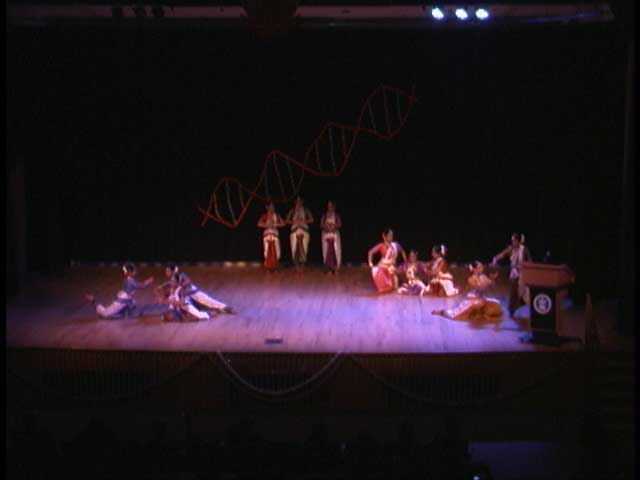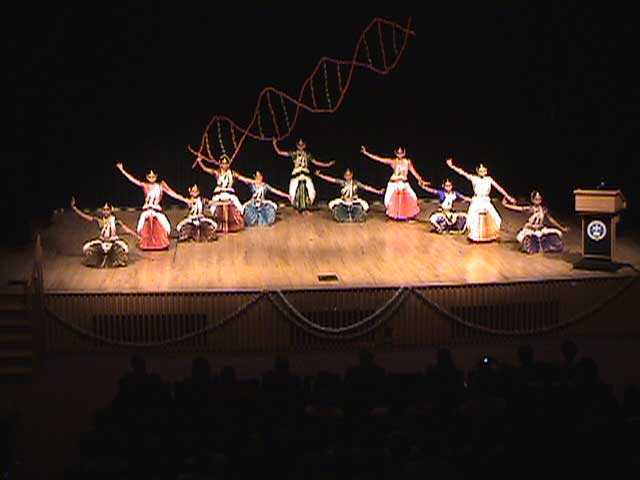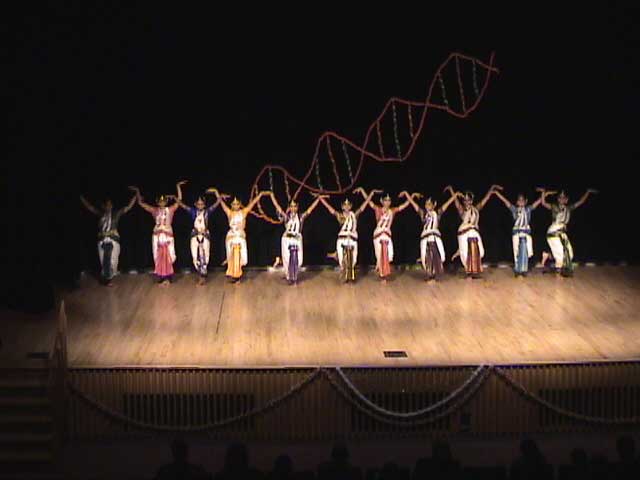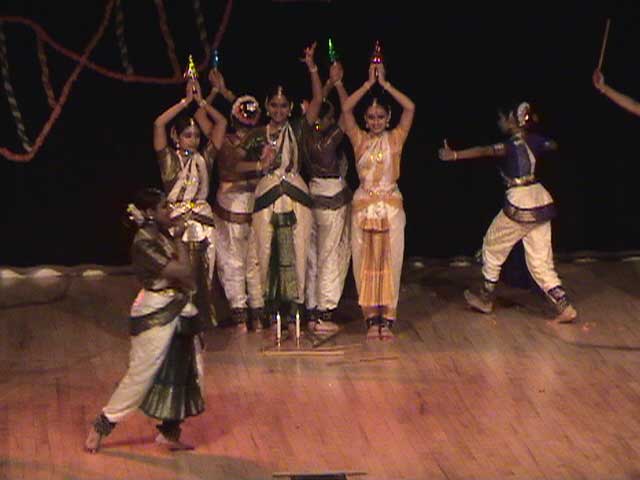Contribute
| Dancing Nature's Art: A Review Of DNA And The Art Of Bharatanatyam |
Dr. Nancy Moses
09/20/2004
Dance often draws its inspiration from the world around us, and that sometimes includes the scientific world. Modern dance has often looked to science for inspiration and composition, and artists in general often look to nature to give them subject matter for exploration. While I have occasionally seen dance used to illustrate science, I was absolutely astounded at the program Dancing Nature's Art presented at Tufts University, Medford, MA on September, 5 2004. What was completely unique was that the scientific principles of DNA were illustrated and explored through the dance style of Bharatanatyam, an ancient Indian Classical dance form that dates back to almost 200 BC. The program was an amazing blend of the ancient dance form and current scientific principles.
Eleven students trained in the art of Bharatanatyam studied the science of DNA under the guidance of Dr. Balram Singh, Professor of Chemistry and Biochemistry at UMASS Dartmouth. They then translated the science into dance under the coaching of two masters of the dance art of Bharatanatyam, Ranjani Saigal, Director of the Eastern Rhythm School of Dance in Burlington, and Kausalya Srinivasan, Senior Fellow of Dance at the University College Citizenship and Public Service at Tufts University. Under the careful guidance of these teachers, the students created their own story of the Origin of Life, the characteristics of the Double Helix, and the discovery of the structure of DNA. They even explored the processes of replication, transcription and translation and illustrated the concepts of mutation and genetic disorders. I have never seen such an effective explanation of night blindness and hemophilia, and I will remember the illustration of cloning and stem cell research better than the explanations of my college biology class because of this creative illustration.
The program maintained the structure of a presentation of classical Indian dance, even starting and ending with a prayer in movement, artistically choreographed by the students using the Bharatanatyam movement vocabulary. They followed the opening prayer with a beautiful and sensitive dance drama of the Origin of Life and the Dance of the Nucleotides, followed by the story of Evolution, Food Chain, Predators and Prey. The students did a credible job of communicating these topics through the classical movement but with creative compositions and dramatic groupings worthy of the best of dance choreography. The performance of the work showed the impressively difficult art of Bharatanatyam performed with confidence and poise and with significant dramatic presence.
Other sections of the program were illustrated with projections that helped explain the science. The students took turns providing an informative narration that helped the audience understand the concepts and acted to connect the dance with the various topics of the program. All of this was done in the dramatic context of the dance and provided a sense of continuity for the audience.
The program was outstanding not only because the students addressed and illustrated the science of the DNA, but they also explored the cultural context and history of the science. They took the time to explore the social and emotional impact of the science, particularly effectively in the mutation and genetic disorders segment. It was obvious that the students had not only studied and understood the science, but they had also considered the effect the application of the science has on our everyday lives. The entire presentation was sensitively and humanistically done.
The fine guidance of the master teachers was evident in the professional level production details. The authentic Indian costumes were beautiful, showing a rainbow of color in motion. The lighting was so effective that you almost didn't notice it, but it enhanced all the content and made for an aesthetic frame for the program. The music, which was composed especially for the production, was recorded by Prasanna & Lalgudi G.J.R. Krishnan. Lyrics were provided by Padmashri Vairamuthu. The music was sensitively used in support of the choreography, blending a variety of styles and musical expression.
The students and their mentors put together an impressive presentation of dance illustrating science in an artistic and professional level performance. It was an enjoyable afternoon of dance and an important lesson in the value and flexibility of all forms of dance expression.
List of Performers
Aarthi Ananthanaryanan - Sophomore, Tufts University
Manaswini Garimella - Senior , Lexington, MA
Nivedita Gunturi - Junior, Tufts University
Megan Jayraj - Senior, San Diego, CA
Somiya Kalloo - Eighth Grader, Lexington, MA
Nivedita Muralidhar - Sophomore, Lexington, MA
Komal Patel - Junior, Burlington, MA
Vinisha Patel - Junior, Burlington, MA
Amudha Pazhanisamy - Freshman, Lexington, MA
Amrita Saigal - Junior, Burlington, MA
Vishnupriya Samudrala - Junior, Westborough, MA
A second performance of this presentation will be held on October 10th 3 - 5pm at the University Of Massachusetts, Dartmouth. For further information please check http://www.lokvani.com/dnadance/umass.jpg
You may also access this article through our web-site http://www.lokvani.com/
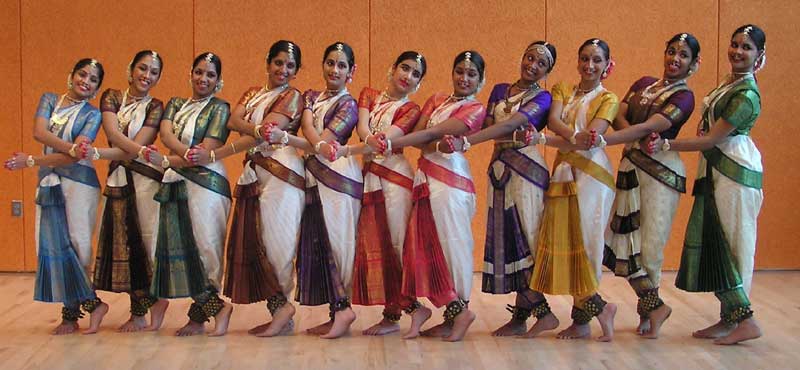
Komal Patel, Vinisha Patel, Amrita Saigal, Nivedita Gunturi, Manaswini Garimella, Somiya Kalloo, Megan Jayraj, Amudha Pazhanisamy, Vishnupriya Samudrala, Aarthi Ananthanarayanan, Nivedita Muralidhar
